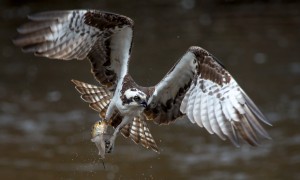Watching the Raptors: ASRI trains citizens to monitor Ospreys

An Osprey carries its meal. In addition to sharp talons, Ospreys have scaley feet that make gripping fish more secure. Photo: Ed Hughes.
For more photos, facts, and stories about the outdoors, “follow” Science and Nature for a Pie on Facebook: www.facebook.com/scienceandnatureforapie.
They’re at the water: large, black and white birds soaring a hundred or more feet in the skies. Suddenly, they appear to hover in midair, five-foot wings changing to a scooping motion that allows them to pause and look. Then, the long wings tuck close to the body as they plunge headfirst. With a raucous splash, they dive into the water. In nearly the same motion, they quickly rise to the surface, and with a mighty thrust of the wings they are airborne again, only this time with a fish clutched in talons that resemble black fish hooks. They shake off the water still dripping from their wings as they continue to rise higher, then soar off to their nests, carrying the catch to share with a mate. Ospreys, large diurnal raptors, will repeat this behavior from spring through most of the summer.
And the Audubon Society of Rhode Island (ASRI) wants you to be one of the people to watch it. On the next two Saturdays, March 15 and 22, ASRI is offering free orientation sessions to people interested in devoting 15 minutes a week to watching Ospreys.
Jon Scoones, Director of Volunteer Services with ASRI, says the organization took over monitoring Ospreys from DEM six years ago. DEM began monitoring them in 1972, when the pesticide DDT was discovered to produce the same effect on Ospreys as on Bald Eagles: thinning of the egg shells, making them more prone to breakage and drastically reducing the reproductive success rate. Both species consumed fish as a large part of their diet. Runoff from farms spraying with DDT put the chemical in the water, which in turn found its way into the fish, eventually impacting the birds’ survival.
“When DEM started monitoring Ospreys back then, they had 12 nests in the whole state,” Scoones says. “Last year, we monitored about 200. That’s why we say they’re a really important indicator of the health of the ecosystem.”
That first year in 1972, a scant eight fledglings survived the season. According to ASRI’s Osprey newsletter, 186 chicks survived to fledge last year. “Fledging” is the term for a first year bird able to fly from the nest on its own.
The requirements for becoming a monitor are simple. All that are needed are a pair of binoculars or scope, a field journal, and the ability to put the observations into the computer. Monitors are assigned one or more nests (depending on their interest and ability to monitor them) and will be expected to spend at least 15 minutes a week making observations. “Our monitors will look for things like ‘housekeeping’, which is when the birds are building or repairing a nest (most Ospreys return to the same nest every year, often for a decade or more). Is there a pair? Do they appear to be exhibiting mating or courtship behavior?” Ospreys often nest on platforms placed high atop poles. Once they begin sitting on eggs (males and females both share the duty, though females take on most of the sitting), it isn’t possible to see whether there are eggs. However, when one partner brings food to the other, it’s a good indication that there are eggs present.
Monitors will continue reporting on Osprey behavior from spring through the summer, until they depart for winter quarters in late August or early September. From there, the raptors (and hopefully the fledglings) will fly off to destinations ranging from Florida to South America.
“We had 66 volunteer monitors last year,” says Scoone. “It’d be great to get that number up to a hundred this year.”
Volunteers from around the state are needed, Scoone says. While the two orientations are in Bristol and Smithfield, there are nests around the state that will need monitoring.
Scoones says that volunteers, known as “citizen scientists”, make an important contribution to scientific knowledge. “Scientists don’t have the time or resources to put in the field work on hundreds of nests. Volunteers fill that gap, and monitoring Ospreys is a great way to get people excited and have them learn about and protect the birds.”
Contact Jon Scoones to find out more: jscoones@asri.org or
401-949-5454 x3044








I’m monitoring the osprey platform at Bold Point in Providence. I watched the pair mate on April 18th. Currently the female is incubating eggs and the male is hanging close by, bringing fish to her.